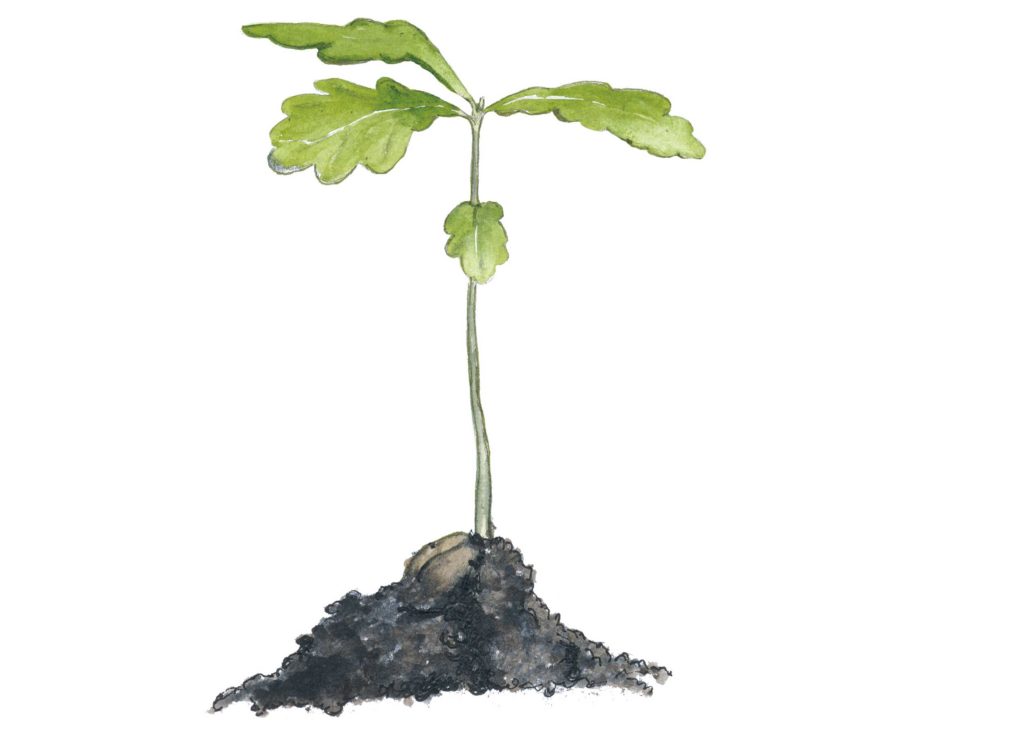In oak landscapes where there is a shortage of young oaks as well as flowering bushes and small trees, planting can be a valuable and suitable measure. This is particularly important in and around oak landscapes that are worthy of protection and where there is a lack of natural rejuvenation. In the project Life Bridging the Gap, we are planting in several areas, in order to bridge the gap in time and space. In the project, planting takes place mainly on pastures and former spruce plantings.
Plant placement
How, where, and how densely should the plants be planted? There’s no simple answer to this question, but the crown of an old oak can be measure more than 25 metres in diameter. We normally plant more densely than that, because many trees die before reaching maturity. It’s a good idea to plant the oaks both as solitaries and in groups. They should not be planted only as solitaries because middle-aged groups of oaks can develop old-tree qualities faster than solitary trees.
The plantings are done in a mosaic, natural fashion, based on the local preconditions, and on each area’s history and goals. It can be a good idea to plant thorny bushes around the oaks, as these will protect the oaks when the protective fencing is removed. Also the bushes produce nectar and pollen relatively soon after planting. Blossoming bushes and small trees are planted also to strengthen the transitional habitats. Further, the plantings can increase habitats in the landscape, by functioning as islands or ‘stepping stones’.
Small or large plants
In Life Bridging the Gap we have chosen to plant trees and bushes of different sizes. Planting larger trees and bushes has many advantages. They soon reach a size where they cannot be eaten by game or by grazing animals, they create nectar and pollen sooner, and, with the right care, they survive better than small plants. If small plants are used, you need more of them, larger areas and protective fencing. The disadvantages of large plants are higher costs, more work to establish them when planting, and greater irrigation requirements in the years after planting.
For the project, the oaks were planted in different sizes: a size called ‘small trees’ (about two metres tall), and one- or two-year-old plants (50-80 cm tall). Bushes and small trees of various sizes were also planted, in various sizes depending on supply: from 50-80 cm tall bare-root or container plants to roughly one-metre tall pot-grown plants. Container plants and potted plants are more expensive than bare-root plants, but they are less sensitive in terms of handling and establishment.
The adjacent table shows the species selected for planting in a large nature reserve in Linköping Municipality. It also shows the distribution between each species and the various plant sizes used.
Origin and quality
The plants’ origin is important. For this reason, all the oaks planted in the project have local origins and are grown on contract at nurseries. The aim should be to use basic material that is as local as possible, for as many species as possible. In this project, this has not been possible for every species of bush and tree planted. Instead, most of the plants have been of the E-plant quality, with guaranteed Swedish basic material.
Planting bed
For larger plants like oaks that are the size of small trees (two metres tall), a planting bed of about 70x70x70 cm is prepared, where the existing soil is mixed with a similar volume of planting soil. On stiff, muddy soil, the ground may need to be broken up a bit outside the bed. The planting bed should be raised, compared to the surrounding ground, so the surface water will sink down into the bed. For smaller plants, the ground only needs to be tilled and broken up before planting. The plants must be protected from competition from grass and weeds. We have used regular ground cloth from a garden centre, and shredded leaves. Based on our experience, shredded leaves are preferable, as the ground cloth can, over time, be difficult to keep in place. And after a few years, the ground cloth must be removed, making it much more labour-intensive than shredded leaves.
Planting time
Late autumn is a good time for planting because oaks are very sensitive to drought when establishing. In late autumn the plants are winter-ready, and the ground can settle properly through the entire winter and spring, before the plants start to grow.
Protective fencing
The plantings need protective fencing. The choice of fencing depends on which animals are the main threat to the plants. In grazing pastures where there are cows, we fence in large oaks with 1.8 metre high rabbit-proof wildlife fencing, with a wooden beam along the top. Also, tall wildlife fencing protects against split-hooved wild animals. In areas with sheep or hare, a 1.2-metre fence is sufficient.

